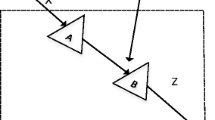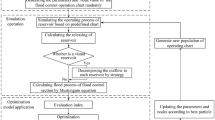Abstract
Reservoirs are among the most effective tools for integrated water resources development and management. The dynamic control of reservoir flood limiting water level (FLWL) is a valuable and effective method to compromise the flood control and conservation for reservoir operation during the flood season. This paper focuses on joint operation and dynamic control of FLWL for cascade reservoirs. A composition and decomposition-based model that consists of an aggregation module, a storage decomposition module and a simulation operation module was developed. The model was applied to the Qingjiang basin in south of China using the 3-hour inflow data series for representative hydrological years. Application results indicate that the proposed model can make an effective tradeoff between the flood control and hydropower generation. Joint operation and dynamic control of FLWL can increase power production by 4.51 % (1.79 × 108 kWh) and increase water use rate by 2.73 %. It can enhance benefits of the Qingjiang cascade reservoirs without compromising flood prevention objectives.








Similar content being viewed by others
References
Al-Humoud JM, Esen I (2006) Approximate method for the estimation of Muskingum flood routing parameters. Water Resour Manag 20(6):979–990
Archibald TW, McKinnon KIM, Thomas LC (1997) An aggregate stochastic dynamic programming model of multireservoir systems. Water Resour Res 33(2):333–340
Fang B, Guo SL, Wang SX, Liu P, Xiao Y (2007) Non-identical models for seasonal flood frequency analysis. Hydrol Sci J 52(5):974–991
Guo SL, Zhang HG, Chen H, Peng DZ, Liu P, Pang B (2004) A reservoir flood forecasting and control system in China. Hydrol Sci J 49(6):959–972
Guo SL, Chen JH, Li Y, Liu P, Li TY (2011) Joint operation of the multi-reservoir system of the Three Gorges and the Qingjiang cascade reservoirs. Energies 4(7):1036–1050
Kumar DN, Baliarsingh F (2009) Optimal reservoir operation for flood control using folded dynamic programming. Water Resour Manag 24(6):1045–1064
Labadie J (2004) Optimal operation of multi-reservoir systems: state-of-the-art review. J Water Resour Plan Manag 130(2):93–111
Li X, Guo SL, Liu P, Chen GY (2010) Dynamic control of flood limited water level for reservoir operation by considering inflow uncertainty. J Hydrol 391(1–2):124–132
Liu P, Guo SL, Li W (2008) Optimal design of seasonal flood control water levels for the Three Gorges Reservoir. IAHS Publ 319:270–278
Liu P, Guo SL, Xu XW, Chen JH (2011) Derivation of aggregation-based joint operating rule curves for cascade hydropower reservoirs. Water Resour Manag 25(13):3177–3200
Nandalal KDW, Bogardi J (2007) Dynamic programming based operation of reservoirs: applicability and limits. Cambridge University Press, New York
Ngo L, Madsen H, Rosbjerg D (2007) Simulation and optimization modeling approach for operation of the Hoa Binh reservoir, Vietnam. J Hydrol 336(3–4):269–281
Turgeon A (1981) Optimal short-term hydro scheduling from the principle of progressive optimality. Water Resour Res 17(3):481–486
USACE (US Army Corps of Engineers) (1998) HEC-5: simulation of flood control and conservation systems. Hydrologic Engineering Center, Davis
WCD (World Commission on Dams) (2000) Dams and development: a new framework for decision-making. Earthscan Publications Ltd, London and Sterling
Xu Z, Ito K, Liao S, Wang L (1997) Incorporating inflow uncertainty into risk assessment for reservoir operation. Stoch Hydrol Hydraul 11(5):433–448
Yeh W (1985) Reservoir management and operations models: a state-of-the-art review. Water Resour Res 21(12):1797–1818
Yun R, Singh VP (2008) Multiple duration limited water level and dynamic limited water level for flood control, with implication on water supply. J Hydrol 354(1–4):160–170
Acknowledgments
This study was financially supported by the National Key Technologies Research and Development Program of China (2009BAC56B02,2009BAC56B04). The authors are grateful for Dr David Emmanuel Rheinheimer to improve the early version of this paper.
Author information
Authors and Affiliations
Corresponding author
Rights and permissions
About this article
Cite this article
Chen, J., Guo, S., Li, Y. et al. Joint Operation and Dynamic Control of Flood Limiting Water Levels for Cascade Reservoirs. Water Resour Manage 27, 749–763 (2013). https://doi.org/10.1007/s11269-012-0213-z
Received:
Accepted:
Published:
Issue Date:
DOI: https://doi.org/10.1007/s11269-012-0213-z




